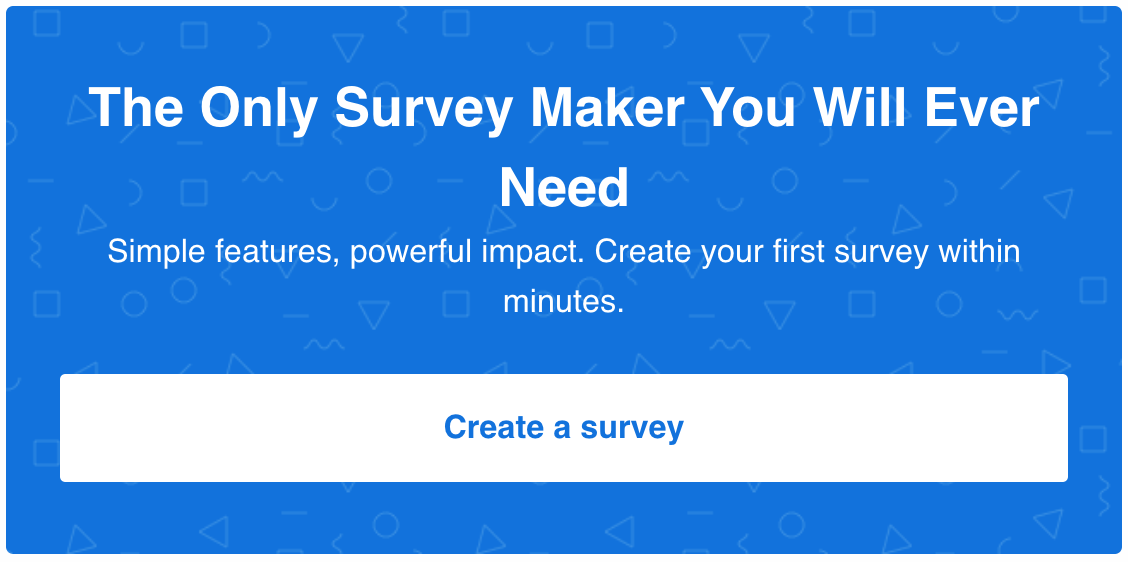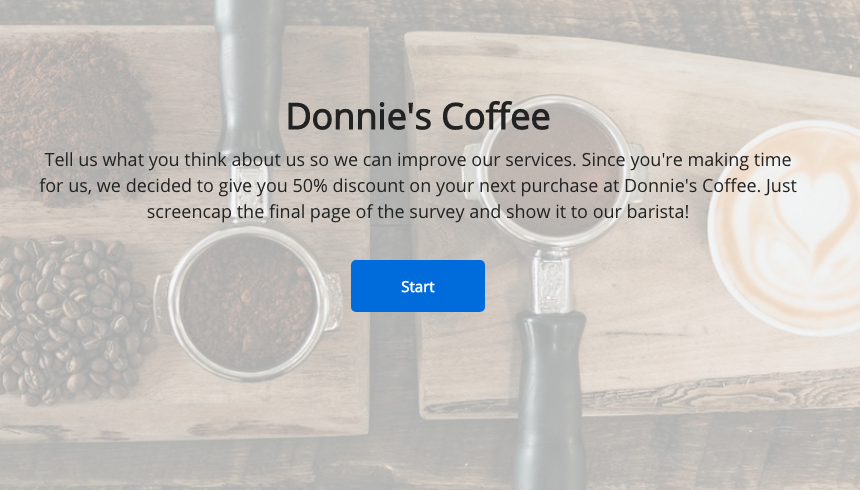We’ve written about the ways to make quizzes and surveys that are a valuable source of information about your customers. In this post, we tackle the old quantitative vs. qualitative survey dilemma. We will also show you how to maximize the validity of online surveys by merging qualitative and quantitative research method.
Market research is the first step of your product development and marketing strategy. Before you make an important business decision, you also want to make sure that your research results are valid and reliable. At the same time, you probably don’t want to spend thousands of dollars on hiring agencies or conducting complicated surveys.
No need to worry about any of these though – finding out what your customers want and think has never been easier. Online surveys are an ever-growing substitute for traditional methods of market research such as one-on-one interviews, phone calls or paper-based surveys.
Why You Should Use Online Surveys
Before we move on to the analysis of the research methods, let’s run through the list of reasons why your survey’s more likely to be successful if you run it online.
-
Online surveys are cheap
By using an online survey maker, you can get in touch with your desired audience and respondents with minimum advertising costs in a short period of time. Something like this would be impossible with one-on-one interviews or cloud phone calls, which involve a lot of logistics, working hours, travel expenses, etc. While paper-based surveys may be slightly cheaper, they also involve print and distribution costs.
-
Online surveys can reach a lot of people
If you place your online survey strategically, thousands of people can see and access it instantly. Improper or small sampling can render your research results useless. Reaching a lot of people increases your chances of gaining insight into opinions and needs of larger demographics.
-
Online surveys are simple to make
With online platforms like this one, you can easily make dozens of surveys, adjust the questions, answers, results, and add multimedia content. The pre-designed templates and simple drag&drop menu save your time, leaving you to focus on what’s really important – creating a simple yet effective content that will compel people to respond to your questions.
-
Online surveys are reliable
Thanks to their large outreach and simplicity, you can draw fairly reliable conclusions about your customers’ opinions and needs.
-
Online surveys are flexible
With paper-based surveys, you were “stuck” with the same group of generalizable questions and you didn’t have a chance to edit or rephrase the content that was confusing to the respondents. With online surveys, if you see that a particular question confuses people and leads to vague or irrelevant answers, you can always come back and fix it.
However, all of these perks of online surveys mean nothing if you don’t organize your research right. One of the prerequisites of a successful survey is the correct use of quantitative vs. qualitative method, so let’s look into their differences.
Quantitative Research
To put it in simplest terms – quantitative research provides the answers to the questions:
- Who?
- What?
- When?
- Where?
- How many?
…and this is why, most of the time, you’ll be using quantitative surveys to learn about your customers and make important business decisions.
The answers in the quantitative survey survey can be transformed into numbers, tables, charts or graphs. Quantitative survey questions are usually close-ended in accordance with the research goals.
For example, you will use this method if you want to find out how many people bought your product. Furthermore, you can measure their level of satisfaction by creating a scale of 1-5. So, quantitative research is good for:
-
Testing the existing ideas/predictions
With the quantitative survey, you can work with the ideas and predictions you already have. For example, you can find out whether lower prices of a certain product are the primary reason the sales of your product went down.
-
Measuring general trends
You can measure the success of your product, find out whether your competitor is outselling you or which services of yours need improvement.
Qualitative Research
Qualitative research provides the answers to the questions:
- Why?
- How?
This type of survey is more likely to incorporate open-ended questions and descriptive answers with little or no numerical value. A qualitative survey is a way to explore people’s thoughts and behavior, possibly the ones you discovered using quantitative research. Qualitative research is good for:
-
Finding ideas/formulating predictions
This type of research is a great way to explore a certain field in great detail. Using a qualitative method, you can run into ideas, problems, and opportunities you weren’t previously aware of, and use the quantitative research to test their value or accuracy.
-
Explaining the numbers
Once you quantify the results of a quantitative survey, qualitative research helps you add more depth to them. For example, quantitative research will show you that your customers dislike several things about your products, but qualitative research will help you understand why.
Qualitative vs. Quantitative Survey – Which One Should I Use?
There is no qualitative vs quantitative survey, actually. The right answer is – you should use both. These research methods are not at odds – they produce the best result when you combine them. Both methods are part of a larger research strategy. Quantitative survey results are something you can rely on to make big, rational decisions based on cold hard numbers. But qualitative survey will give your product, business plan or marketing strategy some finesse that can help you personalize your services or get ahead of your competitors.
We created a short survey to show you how to blend these two approaches for maximum results. Let’s imagine that you have a coffee shop and that you want to know what your customers think about your product and service. This is how a survey looks in an online content builder.
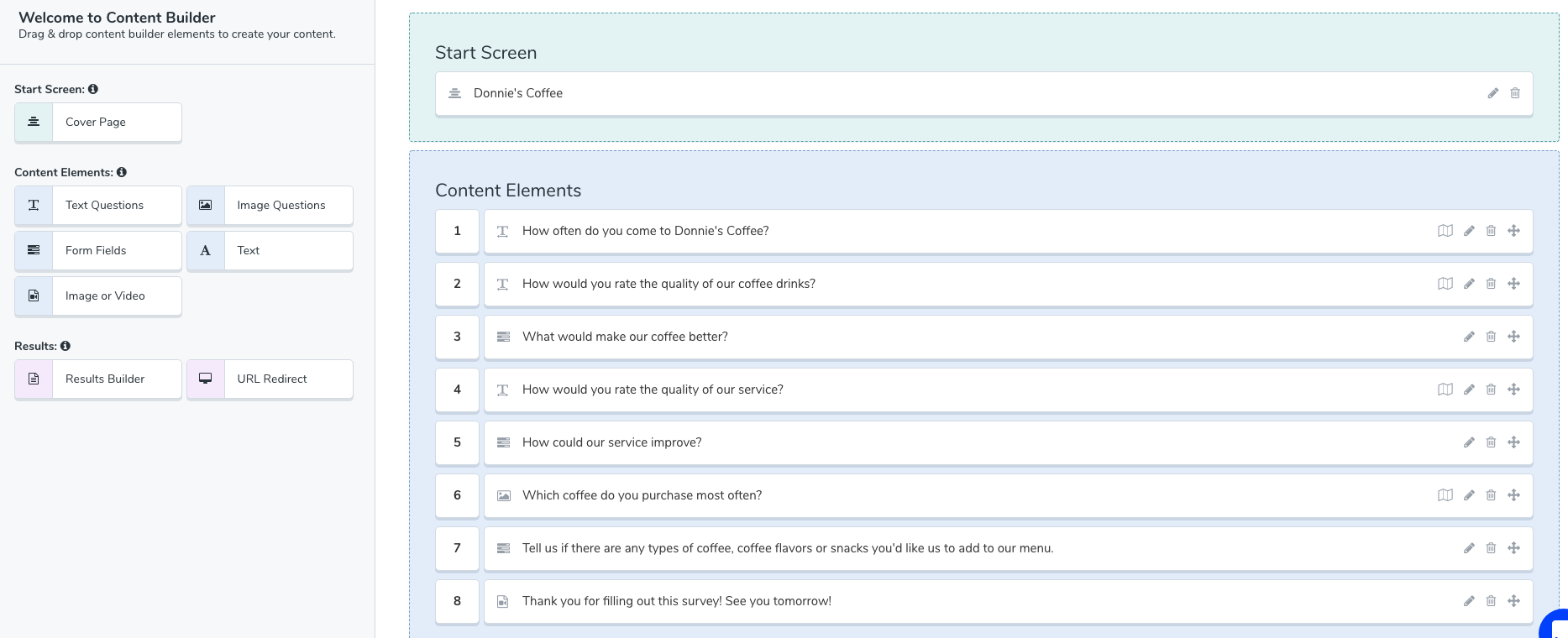

With a tool like this, you can make a survey in 15 minutes and embed it on your website, publish and advertise it on social networks or send it to your email list. You can shape and design the content any way you like – add text, pictures or videos. Click here to try it by yourself.
We decided to include a little incentive for survey respondents in order to maximize the sample for reliable results.
Click here to see how this survey looks.
When you ask people about people’s daily habits, you may discover that sometimes they aren’t the most reliable narrators of their lives. This is why close-ended questions like this are the best way to nudge their memory and segment the answers into distinguishable categories.
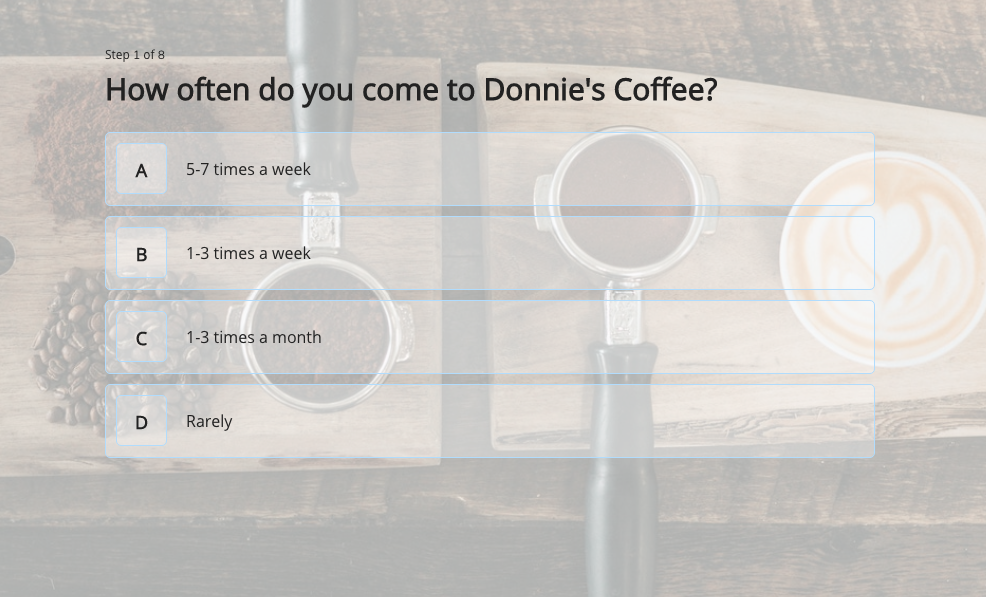

Each question you ask here could swing both ways. You can ask people “what do you think about our coffee?” but you may get thousands of answers that cannot be quantified well. For example, someone could answer “I think it has a unique taste.” This is a very vague answer in terms of your quality rating – unique taste can be anything from “fine” to “excellent.” Try this instead.
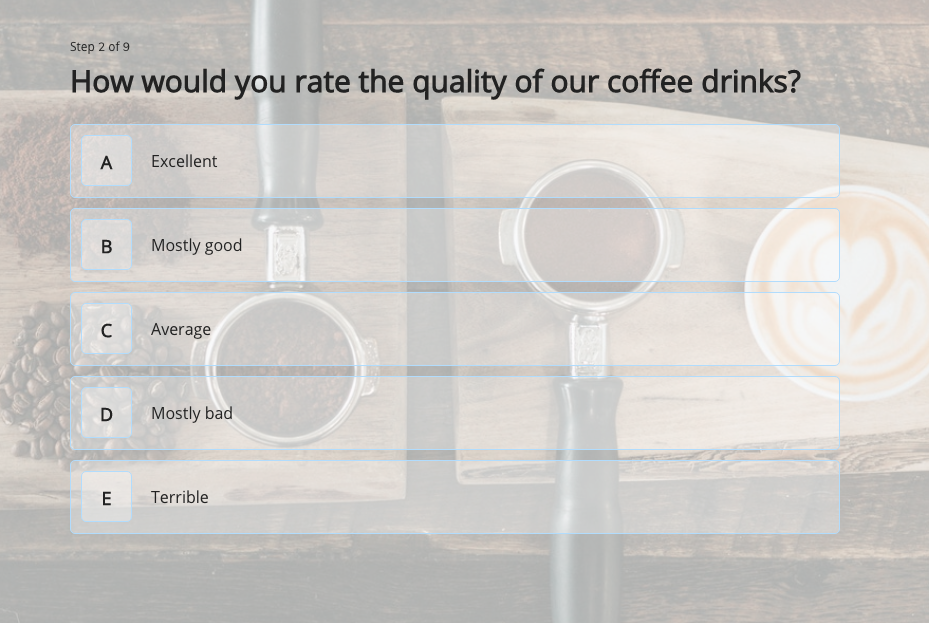

However, if someone tells you that your coffee is terrible, average or mostly good, you cannot really guess the reason. You can offer people close-ended answers such as “coffee beans are bad” or “it is not prepared well,” but you probably cannot think of all the options. Feedback should always be qualitative – you may get a number of answers you expected, but you could also discover the things you didn’t even notice before.
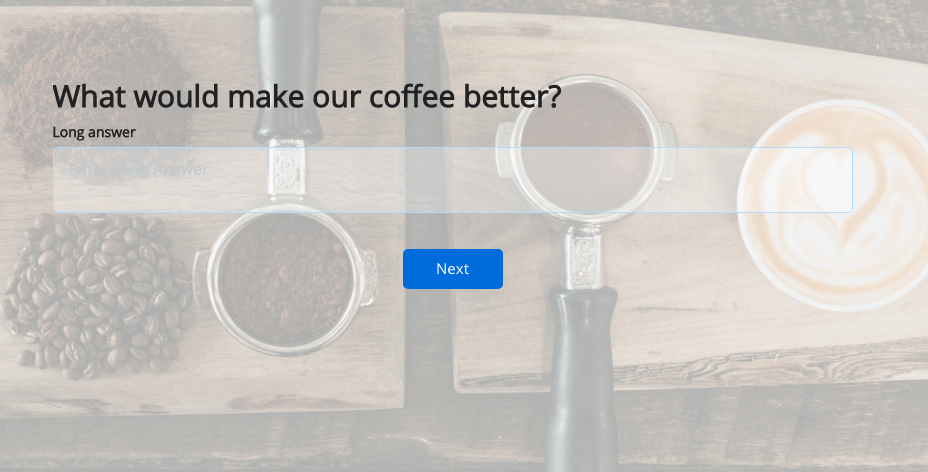

If your offer includes multiple products, you can make your survey look more organized and visually segmented by adding image based answers. It will help people recognize the products they love and prevent them from overlooking the ones they may like but purchase only occasionally.
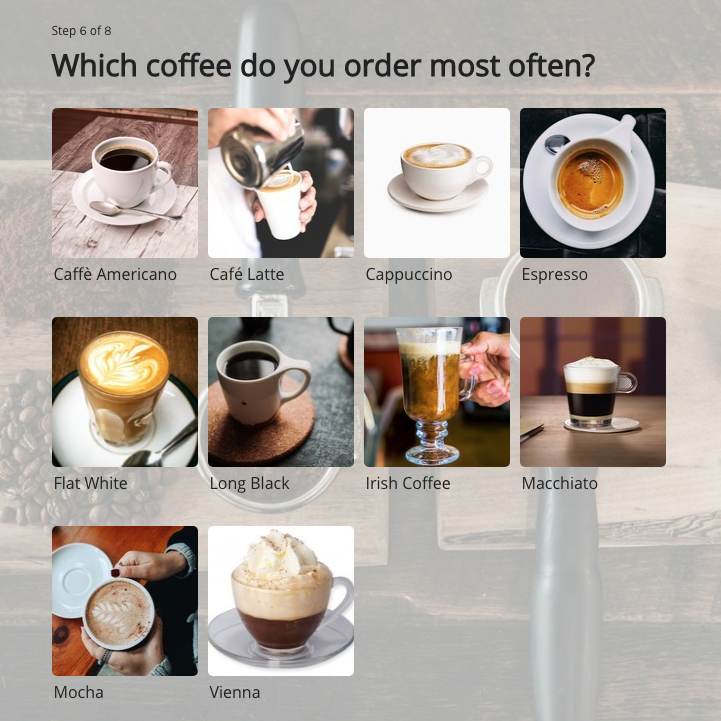

When it comes to new ideas and suggestions, stick with the qualitative method. You may find out that many of your customers want you to start serving muffins or adding extra flavors to your coffee.
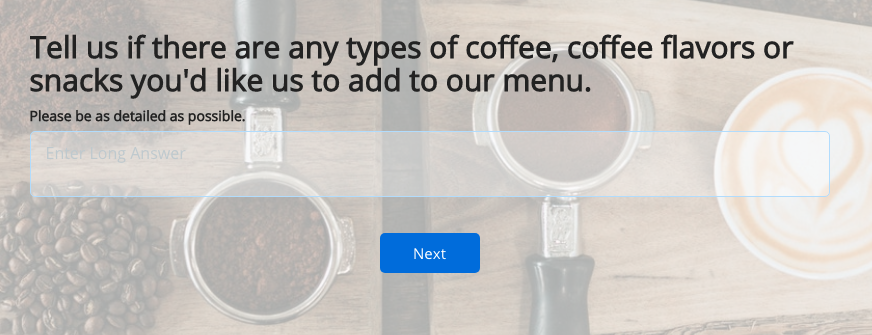

Try to quantify as many questions as possible – and keep in mind that too many open-ended questions could lead respondents to run out of patience and opt out of your survey. Close-ended questionnaires require less time and effort to fill out.
We’ve used a simple example here. However, if you are doing a big research to explore the market opportunity, which requires a large sample of people who aren’t your leads or existing customers, the survey becomes more complex. In this article, you can find more details about making online surveys and quizzes as reliable sources of data.
Quantitative vs. Qualitative Survey Data – Analysis
If your survey is simple like the one we’ve shown you here, there is no need to get too deep in analyzing the results. Calculating a frequency distribution and a percent distribution should provide you with all the answers you need.
A frequency distribution is the number of times a particular answer was given to a particular question or value is found in the dataset. A percent distribution is the proportion of answers given to each question.
If your analysis is more complex – for example, if you want to draw conclusions about larger population or the way certain answers relate to some demographics, your analysis has to follow the rules of statistics. Here you can find a detailed description of the analysis process.
When you are analyzing qualitative data, start by reading the answers several times and taking notes about your impressions and answers that stick out. Seek themes or patterns that may emerge. Weed out data that is irrelevant to your research goal. Analyze the content of answers, seek for words, patterns, and meanings, and then look for new answers that emerged. If your research is more complex, here you will find a useful guide.
With this information and LeadQuizzes content builder, you can make an unlimited number of quizzes, surveys, and forms you can use to capture the attention of your potential customers, organize your business and make informed decisions.
